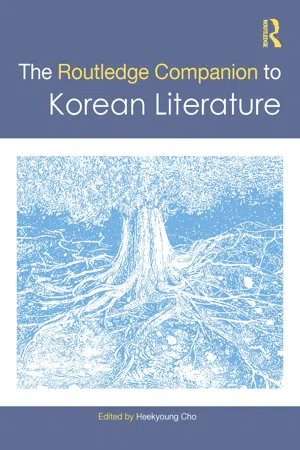
- 730 pages
- English
- ePUB (mobile friendly)
- Available on iOS & Android
The Routledge Companion to Korean Literature
About This Book
The Routledge Companion to Korean Literature consists of 35 chapters written by leaders in the field, who explore significant topics and who have pioneered innovative approaches. The collection highlights the most dynamic current scholarship on Korean literature, presenting rigorous literary analysis, interdisciplinary methodologies, and transregional thinking so as to provide a valuable and inspiring resource for researchers and students alike. This Companion has particular significance as the most extensive collection to date of English-language articles on Korean literature; it both offers a thorough intellectual engagement with current scholarship and addresses a broad range of topics and time periods, from premodern to contemporary. It will contribute to an understanding of literature as part of a broad sociocultural process that aims to put the field into conversation with other fields of study in the humanities and social sciences.
While presenting rigorous and innovative academic research that will be useful to graduate students and researchers, the chapters in the collection are written to be accessible to the average upper-level undergraduate student and include only minimal use of academic jargon. In an effort to provide substantially helpful material for researching, teaching, and learning Korean literature, this Companion includes as an appendix an extensive list of English translations of Korean literature.
Frequently asked questions
Information
PART I Premodern and Early Modern Korean Literature
SECTION I Manuscript Culture, Materiality, Performativity
1 MANUSCRIPT, NOT PRINT, IN THE BOOK WORLD OF CHOSŎN KOREA (1392–1910)
Introduction
Manuscripts as an Aberration in Korean Bibliography
The Chosŏn Book World Beyond Print
Table of contents
- Cover
- Half Title
- Series
- Title
- Copyright
- Contents
- List of Figures
- List of Tables
- List of Contributors
- Acknowledgments
- Notes on Transliteration
- Introduction—Redefined and Challenged: Anthologizing Korean Literary Studies
- Part I Premodern and Early Modern Korean Literature
- Part II Modernity and the Colonial Period
- Part III Liberation and Contemporary Korean Literature
- Part IV Queer Studies, World Literature, the Digital Humanities
- Appendix: A Comprehensive List of English Translations of Korean Literature
- Index